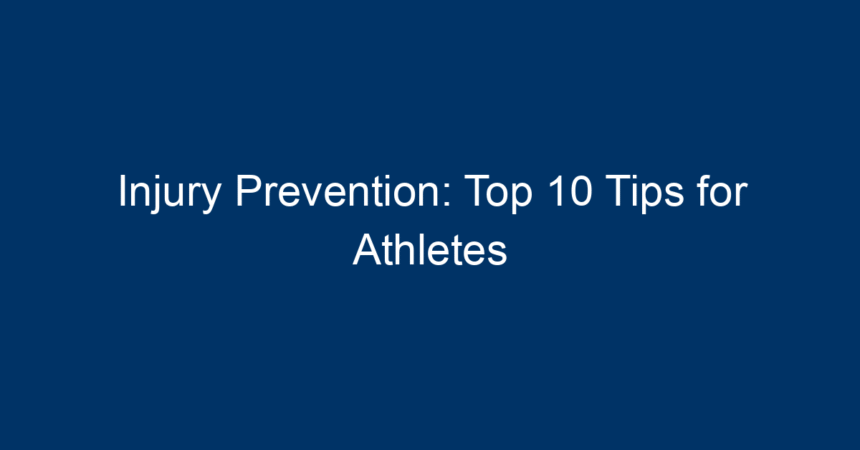Athletes dedicate countless hours to training, honing their skills, and pushing their physical limits in pursuit of excellence. However, with the intense levels of activity and competition, the risk of injury can loom large. Injury prevention is crucial not just for maintaining peak performance but also for ensuring long-term athletic careers. Whether you’re a seasoned pro or just starting out, understanding and implementing effective injury prevention strategies can make a significant difference in your performance and overall well-being.
In this article, we’ll explore the top 10 injury prevention tips designed specifically for athletes. From warm-up routines to recovery techniques, these actionable insights will help you minimize risks and stay in the game longer.
Understanding Injury Prevention
Before diving into the tips, it’s important to grasp the concept of injury prevention. Injury prevention refers to strategies and practices that reduce the risk of injuries during sports and physical activities. This not only includes avoiding potential harm but also entails preparation methods that enhance physical resilience.
1. Prioritize a Proper Warm-Up
A proper warm-up is essential for any athlete. It prepares your body for the physical demands ahead by increasing blood flow to the muscles, enhancing flexibility, and reducing the risk of strains.
- Dynamic Stretching: Incorporate dynamic stretches such as leg swings, arm circles, and torso twists into your warm-up. These movements engage your muscles and joints in a way that static stretching may not.
- Gradual Intensity: Start your warm-up at a lower intensity and gradually increase it to the level required for your sport. This prepares your body for the demands of high-energy plays.
2. Strength Training for Resilience
Building strength not only enhances performance but also fortifies muscles and connective tissues against injuries. Strength training should focus on all major muscle groups to maintain balance.
- Target Weak Areas: Identify and strengthen any muscular imbalances that may lead to injury. For example, runners often benefit from strengthened hip and core muscles.
- Functional Exercises: Incorporate functional movements, such as squats and lunges, which mimic the actions performed during your sport.
3. Embrace Flexibility and Mobility Work
Flexibility plays a vital role in injury prevention. Improved flexibility allows for greater range of motion, reducing the likelihood of strains and tears.
- Regular Stretching: Implement a consistent flexibility routine that includes static and dynamic stretches. This might include yoga or Pilates.
- Foam Rolling: Use foam rollers to release tight spots and enhance muscle readiness.
4. Maintain Good Nutrition and Hydration
What you put into your body significantly affects your performance and injury risk. Proper nutrition fuels your workouts, helps in recovery, and supports your immune system.
- Balanced Diet: Ensure your meals include a balance of carbohydrates, proteins, and healthy fats to fuel your athletic activities. Nutrients like protein are essential for muscle repair and recovery.
- Hydration: Staying hydrated is crucial. Dehydration can lead to muscle cramps and decreased performance. Drink water before, during, and after your workouts.
5. Optimize Recovery Time
Recovery is just as important as training. Allowing your body time to heal and adapt can prevent overuse injuries that plague many athletes.
- Rest Days: Incorporate regular rest days into your training schedule. This gives your muscles time to recover and grow stronger.
- Active Recovery: Engage in low-impact activities like walking, swimming, or cycling to promote blood flow and reduce muscle stiffness during recovery days.
6. Listen to Your Body
Athletes often push through pain and discomfort, but this can lead to serious injuries. Learning to listen to your body can help avoid long-term issues.
- Pain Signals: If you experience persistent pain, don’t ignore it. Consult with a medical professional to assess the situation and avoid worsening the injury.
- Adjust Intensity: Don’t be afraid to modify your training intensity or duration based on how your body feels. It’s better to have a lighter workout today than to be sidelined for weeks.
7. Use Proper Equipment
Using the right equipment is crucial for injury prevention. Poorly fitting shoes or inadequate protective gear can significantly increase your risk of injury.
- Footwear: Invest in sport-specific shoes that provide the necessary support and cushioning for your activity. For runners, shoes that accommodate your gait should be a priority.
- Protective Gear: Always wear appropriate protective gear such as helmets, pads, or braces when engaging in contact or high-risk sports.
8. Incorporate Sport-Specific Training
Tailor your training regimens to the specific demands of your sport. Each sport has unique biomechanical requirements that can influence injury risk.
- Targeted Drills: Incorporate drills that simulate the movements you’ll perform in competition. This prepares your body for the specific stresses it will encounter.
- Cross-Training: Engage in complementary sports or activities that build necessary skills while reducing repetitive strain on the same muscles.
9. Focus on Mental Preparation
Injury prevention isn’t just physical; mental preparedness plays an important role in athletic performance. Being mentally focused can enhance your physical capabilities.
- Visualization Techniques: Use mental imagery to visualize successful performances and injury-free movements. This can boost confidence and reduce anxiety during competitions.
- Mindfulness Practices: Techniques such as meditation or breathing exercises can enhance concentration and reduce stress levels before or during competitions.
10. Regular Assessments and Consultations
Regular assessments from fitness professionals can help you identify potential risks before they become significant issues.
- Physical Assessments: Schedule regular check-ins with a trainer or physical therapist to analyze your technique and identify any weaknesses or imbalances.
- Injury History Review: Discuss your injury history with your healthcare provider to develop a tailored prevention plan moving forward.
Conclusion: Taking Action for Injury Prevention
Implementing these top 10 injury prevention tips will not only keep you in the game longer but can also enhance your performance. Remember, staying proactive is essential—prioritize your health and well-being to ensure that you can continue pursuing your athletic goals.
Start with small changes, like incorporating a structured warm-up into your routine or adjusting your nutrition. Over time, these habits will become second nature, leading you to a more successful, injury-free athletic career. The road to greatness is often paved with smart choices—make injury prevention a priority today!




